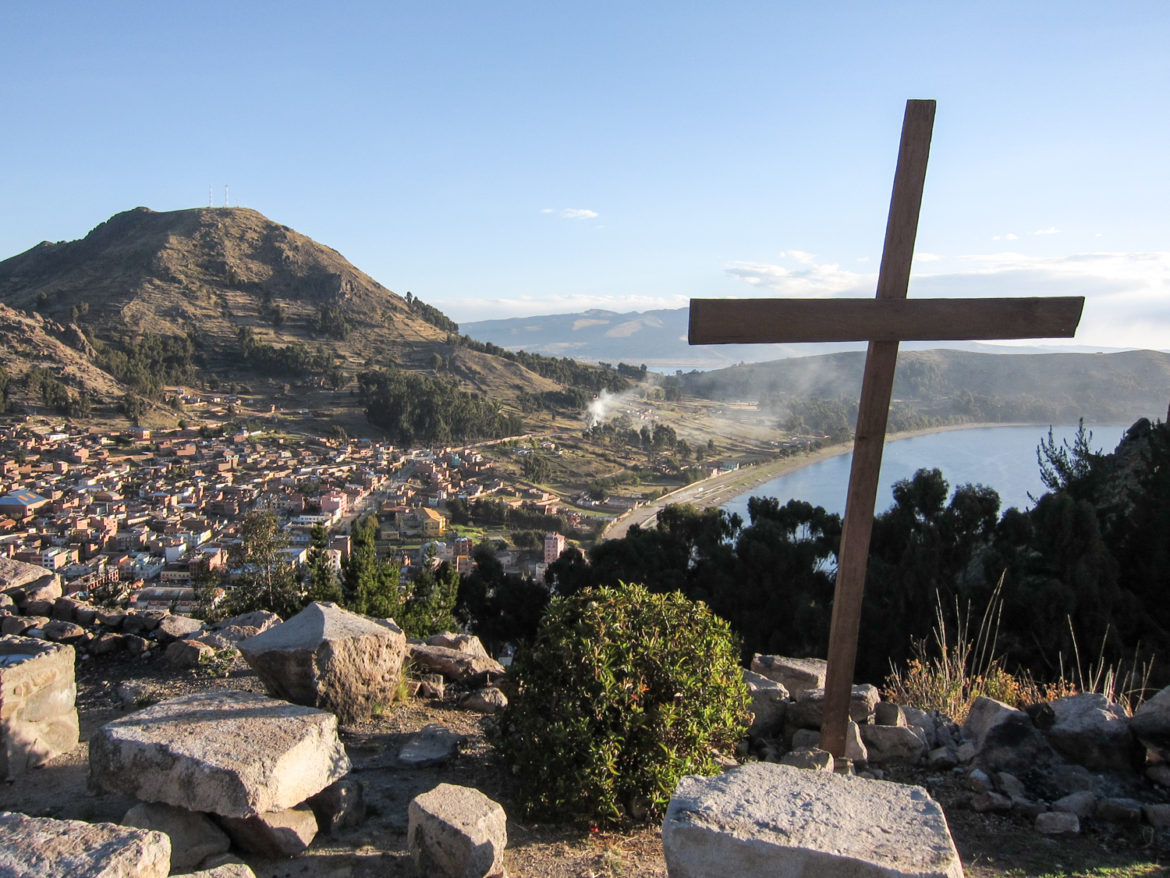Situated on the Bolivian shore of Lake Titicaca, Copacabana is a picturesque town with pastel buildings and beautiful vistas.
The lakeside town is also the original inspiration behind Rio de Janiero’s famed beach of the same name. We read that Bolivia is the most elevated and isolated country in South America, but found Copacabana surprisingly warm, sunny and welcoming.
From Puno, Peru, we took an adventurous three-hour bus ride to cross into Bolivia. Along the way, we encountered sheep tied to truck roofs and skeptical customs officials questioning the validity of our visas. Once in Copacabana, hostel owners crowded around us offering up rooms. By now, this type of arrival had become the norm. We developed a routine down that involved collecting business cards, then escaping to the nearest Tourist Information (usually inside or close to the bus station.) There, we’d get a map and review our options. The telltale sign of being a tourist (i.e. a target) is a backpack. As such, I’d remain with our backpacks at the TI while Brian scouted out a place to stay.
We chose a cozy hostel on Plaza Sucre, then headed out to explore every square inch of town.
We made our way through cobblestone streets lined with colorful homes, many only half-built. Despite the ramshackle nature of the buildings, somehow things felt tidy and organized. Stray dogs took notice of us briefly, then went back to lazing in the sun. We continued our wanders, taking note of influences carried over from Peru. We soaked up the raw, gritty nature of the markets (pig head anyone?) and passed several crowded rotisserie chicken restaurants. In keeping with our quest to try the local beers in every country we visited, we enjoyed a tasty Paceña, an American Lager style beer brewed in the capital, La Paz, where we were heading next.
To our surprise, we also discovered a small expat community of rasta-fied hippies around town. They’d be making jewelry down by the port, eating cheap omelettes or trucha (trout) at La Choza, a hole-in-the-wall restaurant and often performing evening fire hoop routines. With the town’s relaxed vibe and cheap prices, we could understand how easy it would be to simply check out.
Near the main square, Plaza 2 de Febrero, we stopped in the Basilica of Our Lady of Copacabana. This bright, circus-like cathedral is a 16th-century Spanish colonial shrine, dedicated to the patron saint of Bolivia. A major pilgrimage site, it features distinctive Moorish domes and beautiful azulejos (Portuguese-style ceramic tiles).
Nearby, we enjoyed two different hikes that offered distinct Incan and Christian perspectives.
Heading south, we walked less than a half hour to reach Horca del Inca (Inca Gallows). This pre-Incan astronomical observatory is considered one of the area’s most sacred sites. For a nominal fee, we walked along a path dotted with megalithic rock formations that cast shadows to offer insight into the solar system. Sadly, graffiti litters the site, but doesn’t prevent locals from coming and making regular offerings to Pachamama (Mother Earth).
Retracing our steps, we then proceeded north from the cathedral on a moderately strenuous hike. Along the way, we passed the Station Crosses, monuments that represent the 14 Stations of the Cross. Like the cathedral and Horca del Inca, these stations offer locals a place to pray and give thanks. Once at the top of Cerro Colvario (Calvary Hill), we took in the majestic view of Copacabana and Lake Titicaca. In the distance, we could even see Peru – our overnight island visits to Amantani and Taquile, now distant memories.
As the sky grew darker, locals, hippies and tourists alike soon began to gather around. Together, we watched the sun begin its descent into the shimmering lake below. Each with our own beliefs, but likely all feeling gratitude for the incredible natural beauty surrounding us.

